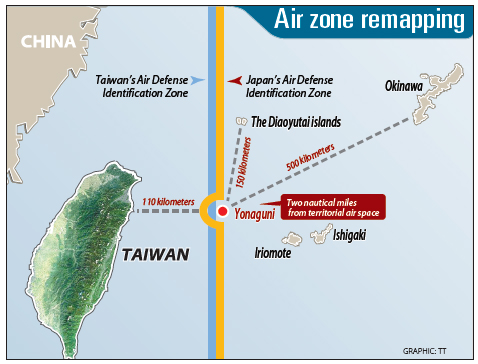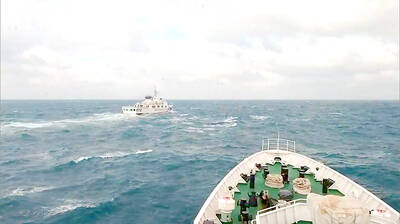Japan has extended its Air Defense Identification Zone (ADIZ) so that it now overlaps with sections of a zone controlled by Taiwan, but foreign affairs officials said yesterday that would not make any difference in practice, as an understanding has been reached between the two parties on how to handle the sensitive matter.
A Ministry of Foreign Affairs (MOFA) official said on condition of anonymity that Tokyo informed Taipei “one or two days ago” that its extension of the ADIZ from Yonaguni Island westwards would come into force yesterday.
An ADIZ is an area of airspace defined by a country within which identification and location of an aircraft is required. Aircraft entering an ADIZ are required to radio their intended course and destination to the country’s air traffic controller, usually both civilian and military.

This was the second time Japan notified Taiwan about the extension plan following a statement by the ministry accusing Tokyo of informing Taipei without consulting it first.
The plan was first reported by the Sankei Shinbum on May 26, five days after the first notification to Taiwan.
The official said Tokyo had no intention of communicating with Taipei on the matter either before the decision was made by the administration of then-Japanese prime minister Yukio Hatoyama, nor after the ministry issued a statement on May 29 expressing “regret” over Japan’s unilateral move.
“Given international norms that ADIZ demarcation is at the discretion of each country, it was natural for Japan not to seek prior approval from Taiwan. However, when there is another country adjacent to the line, consulting with the country in advance is a courtesy,” the official said.
The original ADIZ between Taiwan and Japan runs along longitude 123 degrees east and splits the airspace over Yonaguni Island in half, leaving the area east of the line to Japan and the area west to Taiwan. The line was drawn by the US military after World War II.
The Japanese Ministry of Defense officially announced the new ADIZ line on its Web site on Thursday. Starting yesterday, the ADIZ was extended by 12 nautical miles (22km) from the baseline, with an additional 2 nautical miles as a buffer zone, resulting in an overlap with airspace over which Taiwan holds jurisdiction.
In a telephone interview, Minister of Foreign Affairs Timothy Yang (楊進添) said the government insisted the Taiwan-Japan ADIZ demarcation line “remain unchanged.”
“Each country is entitled to draw its ADIZ. When it comes to overlapping areas, we know how to deal with it. I believe we [Taiwan and Japan] understand each other’s position,” Yang said.
During a meeting at the legislature’s Foreign and National Defense Committee on May 31, Yang agreed to a suggestion by Chinese Nationalist Party (KMT) Legislator Lin Yu-fang (林郁方) that the government ask Japanese aircraft entering Taiwanese airspace in the zone to leave.
Asked by the Taipei Times if this position still held, Yang said “it would depend on the situation.”
“The Ministry of National Defense [MND] is in charge of that issue. However, if, in our judgment, something threatens our airspace, we could have a different reaction,” he said.
MOFA issued a second statement on Thursday night, again expressing “extreme regret” over the rezoning plan and reiterating its opposition to the change.
“There is no possibility the government will make any concession on this issue as it is a matter of national sovereignty,” ministry spokesman Henry Chen (陳銘政) said.
NO PROVOCATIONS
Chen said Taiwan and Japan would not engage in provocations as both sides had made their positions on the matter very clear.
KMT Legislator Liao Wan-ru (廖婉如) said later yesterday that the government should continue requesting negotiations with Japan on the matter.
“The problem isn’t that the ADIZ cannot be redrawn, but rather that Japan should have consulted us instead of making the decision on its own,” Liao said.
Defense ministry spokesman Major General Yu Sy-tue (虞思祖) said yesterday the ministry had a similar position.
Likening the ADIZ issue to the controversial Diaoyutai (釣魚台) Islands, over which Taiwan and Japan claim sovereignty, Chen said both sides would set differences aside and seek acceptable solutions through negotiations.
On reports by Japanese media that the expansion of the ADIZ was part of the Japanese government’s response to a military buildup in China, Yang refused to comment.
CONCERN OVER CHINA
The anonymous official said the rapid growth of the Chinese military in recent years had become a concern for the academic and diplomatic community in Japan.
Democratic Progressive Party Legislator Peng Shao-chin (彭紹瑾) told the Taipei Times last night that Taiwan’s government had to learn how to strike a balance between its relationship with China and with the US-Japan security alliance.
“Japan’s redrawing of the ADIZ suggests that it might not trust Taiwan as much as it used to in light of our government’s moving too close to China,” Peng said.

Taiwan is gearing up to celebrate the New Year at events across the country, headlined by the annual countdown and Taipei 101 fireworks display at midnight. Many of the events are to be livesteamed online. See below for lineups and links: Taipei Taipei’s New Year’s Party 2026 is to begin at 7pm and run until 1am, with the theme “Sailing to the Future.” South Korean girl group KARA is headlining the concert at Taipei City Hall Plaza, with additional performances by Amber An (安心亞), Nick Chou (周湯豪), hip-hop trio Nine One One (玖壹壹), Bii (畢書盡), girl group Genblue (幻藍小熊) and more. The festivities are to

Auckland rang in 2026 with a downtown fireworks display launched from New Zealand’s tallest structure, Sky Tower, making it the first major city to greet the new year at a celebration dampened by rain, while crowds in Taipei braved the elements to watch Taipei 101’s display. South Pacific countries are the first to bid farewell to 2025. Clocks struck midnight in Auckland, with a population of 1.7 million, 18 hours before the famous ball was to drop in New York’s Times Square. The five-minute display involved 3,500 fireworks launched from the 240m Sky Tower. Smaller community events were canceled across New Zealand’s

The Ministry of Foreign Affairs (MOFA) yesterday said it is closely monitoring developments in Venezuela, and would continue to cooperate with democratic allies and work together for regional and global security, stability, and prosperity. The remarks came after the US on Saturday launched a series of airstrikes in Venezuela and kidnapped Venezuelan President Nicolas Maduro, who was later flown to New York along with his wife. The pair face US charges related to drug trafficking and alleged cooperation with gangs designated as terrorist organizations. Maduro has denied the allegations. The ministry said that it is closely monitoring the political and economic situation

‘SLICING METHOD’: In the event of a blockade, the China Coast Guard would intercept Taiwanese ships while its navy would seek to deter foreign intervention China’s military drills around Taiwan this week signaled potential strategies to cut the nation off from energy supplies and foreign military assistance, a US think tank report said. The Chinese People’s Liberation Army (PLA) conducted what it called “Justice Mission 2025” exercises from Monday to Tuesday in five maritime zones and airspace around Taiwan, calling them a warning to “Taiwanese independence” forces. In a report released on Wednesday, the Institute for the Study of War said the exercises effectively simulated blocking shipping routes to major port cities, including Kaohsiung, Keelung and Hualien. Taiwan would be highly vulnerable under such a blockade, because it